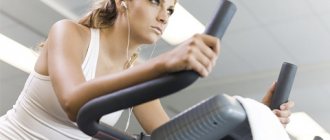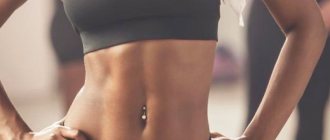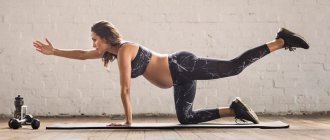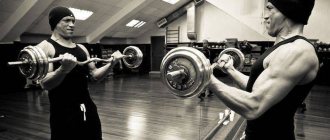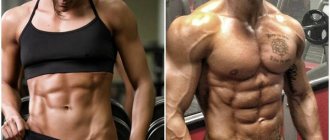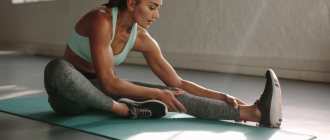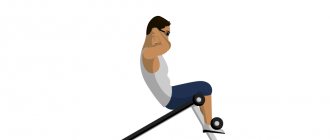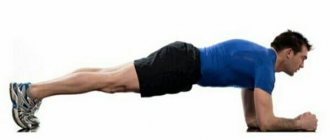Every girl goes through unpleasant sensations caused by menstruation every month. These are pain in the lower abdomen, discomfort and general weakness. And this is also a series of prohibitions on those things that we are used to doing every day, for example, this applies to playing sports. Every girl who visits fitness clubs or works out at home is forced to ask herself every month whether it is possible to continue her exercise during her period. Some people feel fine at this time and are not averse to continuing training, but for others, menstruation is very painful, and it’s basically difficult to do anything, even with all the desire. Be that as it may, you need to figure out whether it is possible to pump up your abs during your period. Why can the answer to this question be positive and why can it be negative?
Sports and critical days
The answer to the question of whether you can pump up your abs while on your period will depend on how you feel. Although here, not everything is so simple. If your stomach does not hurt and there is no discomfort, this is also not always a green light for active sports. In this case, the coin has two sides.
It happens that a woman feels so bad during her period that she can barely get out of bed, and the mere thought of physical activity causes her to panic. Then, under no circumstances should you force your body. It’s better to just rest , otherwise you will get nothing but enormous additional discomfort. Absolute contraindications to physical activity during menstruation are the following factors:
- If the doctor prohibits you from playing sports during your critical days due to certain health problems.
- If your periods are accompanied by unbearable pain, dizziness, heavy discharge and a long duration (more than 7 days).
If a woman’s health is normal, then, in principle, she can pump up her abs during her period. This is not only not prohibited, but can also have a beneficial effect on the course of menstruation. In this case, there is no point in denying yourself the pleasure of exercising, because menstruation is not a disease, but a completely natural physiological state for a woman.
Training options and cycle phases
It is not recommended to twist the body and put stress on the lumbar spine.
The menstrual cycle develops in accordance with three phases:
- follicular;
- ovulation;
- luteal
The duration of the first follicular phase is 10-15 days. There is an increase in folicle hormone and stimulation of the growth of ovarian follicles. The level of estrogen is higher than progesterone. Fat burning occurs faster than sugar. Therefore, training should be less intense.
The period of the ovulation phase is characterized by an increase in the concentration of luteinizing hormone. Ovulation occurs - the egg is released from the ovary into the peritoneal cavity, and the ovarian sac closes. This leads to the production of progesterone, which becomes more abundant than estrogen, as well as active burning of glucose. Then it is recommended to increase the intensity of your training.
Cabbage: white cabbage, cauliflower and broccoli help speed up the metabolism of estrogen during menstruation. To reduce the level of ZHPG in the female body, this product should be included in the diet.
Features of playing sports during menstruation
Usually the first days of menstruation are the most problematic. They are accompanied by copious discharge, sometimes by a clear deterioration in well-being. Experts recommend that even those who feel fine at this time refrain from activities aimed at working the muscles of the lower abs. If you don't pump them for a couple of days, nothing will happen to you, but you will seriously reduce your risk of developing endometriosis. This is one of the reasons why you can’t pump up your abs during your period. In general, in the first 2-3 days it is recommended not to load the abdominal muscles. It is better to devote this time to light cardio training , such as jogging. Here are the recommendations given by experts regarding physical activity on critical days:
- Give preference to exercises that target the upper abdominal muscles and oblique muscles.
- The pace should be stable, do not increase the pace or difficulty of your classes.
- It is very important to listen to the body. If during the exercise you feel that the discharge has become stronger and your health has worsened, stop exercising.
- The choice of clothing for sports is always important, but during menstruation it is especially important. They are usually accompanied by increased sweating, so it is important that your sportswear is made from natural materials and is comfortable.
Doctors and trainers warn that during menstruation, hemoglobin and red blood cell levels clearly decrease due to blood loss.
Because of this, our endurance drops several times. Therefore, it is important to reduce the load, and this applies not only to abdominal exercises, but also to sports in general. As already mentioned, during menstruation it is allowed to do exercises for the upper abs and oblique muscles . But it’s worth holding off on working out your lower abs and all kinds of leg lifts so as not to harm yourself.
How to pump up your abs correctly: harmful exercises
An example of a harmful abdominal exercise is straight leg lifting with a fixed body. Moreover, whether you raise straight legs from a lying position, or do it from a vertical position with emphasis on the lower back, this harms your spine.
Never do this. Have mercy on your spine.
Studies have shown that straight leg raises cause significant compressive stress on the intervertebral discs of the lumbar spine. In this case, the maximum force occurs at the moment the heel lifts off the surface of the plane.
If such a load is carried out regularly, it can lead to the accumulation of microdamages in normal discs, and in degenerative intervertebral discs it can cause damage and an increase in hernial protrusion. Performing this exercise causes the development and progression of osteochondrosis of the lumbar spine. Therefore, if you raise your legs or body with a rigidly fixed lower back, think about the possible consequences.
In this regard, one of the most harmful exercises is the “jackknife” - simultaneous lifting of the torso and legs from the floor:
LJ user dmitriysh wrote a post on this topic, where he talks about the particular harm of the “jackknife”: “The abdominal muscles are tense, and the lower back muscles are relaxed, therefore the entire load when bending falls on the spinal ligaments. As a result, this transition point begins to produce painful symptoms, and this point is in very good reflex relationships with the entire given segment. My lower back starts to hurt. The more you do these exercises, the sooner you will get sick.”
What abdominal exercises can you do during your period?
If there are no contraindications and you feel normal, you can exercise your abs during your period, but it is important to limit yourself to only those exercises that are safe during this period. These include the following:
- Basic exercise. Take a horizontal position, bend your knees, place your hands behind your head. Every second count you need to raise your upper torso to pump your upper abdomen. Don't overdo it - just lift your shoulder blades off the floor.
- Exercise for the oblique abdominal muscles. The starting position is the same as in the previous exercise. Raising your torso, you should touch your knee on the opposite side with your left hand.
- Exercise without lifting the body. You need to lie on your back, bend your knees (move your feet closer to your buttocks), and extend your arms along your body. Use your fingers to touch your ankles, training your oblique abdominal muscles.
These exercises are safe even during critical days. Moreover, they can help relieve pain and overall physical health during periods and have a beneficial effect on our women's health.
Main causes of failures
Most specialists in the field of reproductive function clearly distinguish two main groups of processes in the female body that lead to a disruption in the rhythm of menstruation. These are natural causes and situations caused by various pathologies in patients.
Physiological conditions that affect the menstrual cycle include:
- Woman's age. During puberty, the regularity of menstruation is just becoming established and depends on the woman’s hormonal background. By the age of 15-18, the cycle usually stabilizes. During premenopause, there is a decrease in the release of female sex hormones, which can also lead to a shortening or even periodic disappearance of a woman’s periods. Such problems usually begin in women after 45 years of age.
- The second main cause of menstrual disorder in the absence of pathology is usually associated with pregnancy and breastfeeding. During this period, everything is also connected with hormonal problems. Since this process is purely physiological in nature, menstruation is restored on its own after stabilization of hormonal levels.
But most often in the practice of gynecologists, situations occur when menstrual irregularities are associated with various diseases of the female genital area or other organs and systems. These include various diseases of the ovaries, malfunction of the hormonal system, diabetes mellitus, metabolic disorders and other diseases.
If a patient, without consulting a specialist, begins to use physical exercise to induce menstruation, she most often only provokes a worsening of her condition. Therefore, any interventions in physiology are not recommended to be carried out independently.
A woman must remember that even simple physical overload of the body and nervous stress can affect the menstrual cycle. Similar reasons for the absence or delay of menstruation include hypothermia or chronic dietary disorders.
Before you figure out what physical exercises can induce menstruation, you should seek advice from a gynecologist at the antenatal clinic. In most cases, if the patient does not have diseases that affect the menstrual cycle, the doctor will first of all give recommendations on normalizing the diet, advise reducing stress, and tell you how to establish a proper work and rest schedule.
With such a pathology, you should not immediately resort to physical or chemical effects on the menstrual cycle. In 80% of cases, the patient will be helped by rest, diet and vitamins.
Watch the video about the causes of menstrual irregularities:
Useful advice from experts
In fact, there is no clear answer to the question of whether it is possible to pump up the abs during menstruation, because everything depends on the individual characteristics of the body, the woman’s well-being and the technique of performing the exercises. But all experts agree that the following rules must be followed:
- You should not do exercises in which your legs need to be raised above your navel.
- Excessive stress can only worsen your condition during this difficult period.
- If you exercise regularly and moderately, it will help relieve both menstruation and premenstrual syndrome, which for many women becomes a real hell. Simple abdominal exercises act like a pill, helping to reduce pain.
- Exercising may increase the amount of discharge slightly, but the overall length of your period may decrease.
Hygiene is very important. Shower regularly, wear good sportswear and quality underwear. This will help maintain the health of the reproductive system and prevent a number of problems.
If you listen to your body, while at the same time following the advice of medical specialists and athletes, you will be able to play sports without harming your health, but only with benefit. The main thing is not to overdo it with the load , because during critical days our body is very vulnerable.
Features of the body during menstruation
The hormonal background of a woman in the second half of the menstrual cycle contributes to fluid retention in the body. This occurs due to the activity of the corpus luteum. Thickening of the endometrium in the uterine cavity provokes a rush of blood and lymph to the pelvic organs. A few days before the start of their next period, most women experience weight gain, and some experience swelling. In the last days or hours before the rejection of the used mucosa, a feeling of fullness and heaviness appears in the lower abdomen. Before menstruation begins, the cervical canal of the uterus opens slightly. The appearance of discharge is facilitated by a strong contraction of its muscle fibers. Sometimes it happens so intensely that it causes pain.
Additional load on the abdominal muscle group during sports activities during menstruation has a dual function:
- on the one hand, it promotes the rapid removal of endometrial remnants and cleansing of the uterus;
- on the other hand, it increases the risk of painful spasms.
Abdominal exercises are strength-training exercises based on increased and frequent contraction of the muscle walls. Such intense work causes vasodilation and a rush of blood to the loaded tissues. Against the background of existing tension in the pelvic area, severe physical discomfort may appear.
Particularly unpleasant consequences of zealous exercise await girls who are unprepared in sports, who decide to try to work out on the days of menstruation. An organism unaccustomed to training may respond with pain in the lower back, sides, difficulty breathing, and dizziness, since at the beginning of the monthly cycle all systems are forced to work with great stress. Some experience jumps in blood pressure, physical fatigue quickly sets in, sweating increases, and the pulse quickens. And the lower abdominal muscles become swollen due to the rush of blood. In such a situation, the answer to the question whether it is possible to pump up the abs during menstruation can only be negative. You should not provoke a deterioration in your health during this risky period for your health.
In what order should you pump up your abs in the gym?
In other words, when should you train your abs BEFORE STRENGTH TRAINING or AFTER? ...as always, a very controversial issue. By the way, I am “FOR” both methods. WHY?
Yes, because both methods are good in their own way. Let's take a closer look at the comparison?
- According to my observations, many people “forget” doing abdominal training at the end of the workout (they are stupid to do it after strength training).
- On the other hand, at the beginning of the training, they will not “forget” about it (abs), they even enjoy training it
